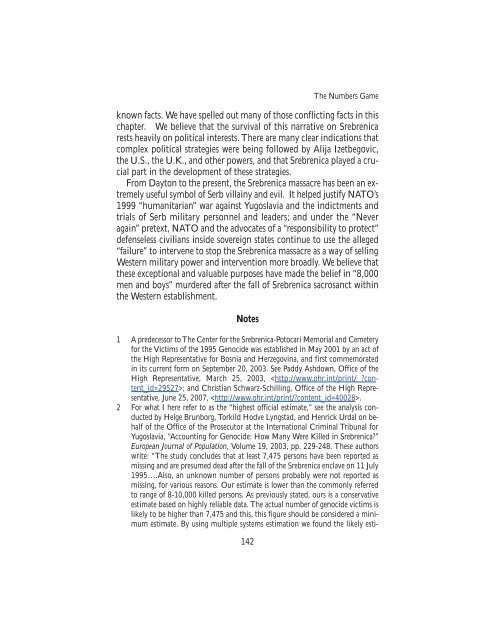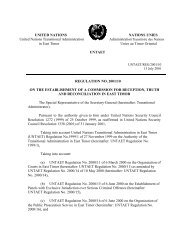The Srebrenica Massacre - Nova Srpska Politicka Misao
The Srebrenica Massacre - Nova Srpska Politicka Misao
The Srebrenica Massacre - Nova Srpska Politicka Misao
You also want an ePaper? Increase the reach of your titles
YUMPU automatically turns print PDFs into web optimized ePapers that Google loves.
<strong>The</strong> Numbers Game<br />
known facts. We have spelled out many of those conflicting facts in this<br />
chapter. We believe that the survival of this narrative on <strong>Srebrenica</strong><br />
rests heavily on political interests. <strong>The</strong>re are many clear indications that<br />
complex political strategies were being followed by Alija Izetbegovic,<br />
the U.S., the U.K., and other powers, and that <strong>Srebrenica</strong> played a crucial<br />
part in the development of these strategies.<br />
From Dayton to the present, the <strong>Srebrenica</strong> massacre has been an extremely<br />
useful symbol of Serb villainy and evil. It helped justify NATO’s<br />
1999 “humanitarian” war against Yugoslavia and the indictments and<br />
trials of Serb military personnel and leaders; and under the “Never<br />
again” pretext, NATO and the advocates of a “responsibility to protect”<br />
defenseless civilians inside sovereign states continue to use the alleged<br />
“failure” to intervene to stop the <strong>Srebrenica</strong> massacre as a way of selling<br />
Western military power and intervention more broadly. We believe that<br />
these exceptional and valuable purposes have made the belief in “8,000<br />
men and boys” murdered after the fall of <strong>Srebrenica</strong> sacrosanct within<br />
the Western establishment.<br />
Notes<br />
1 A predecessor to <strong>The</strong> Center for the <strong>Srebrenica</strong>-Potocari Memorial and Cemetery<br />
for the Victims of the 1995 Genocide was established in May 2001 by an act of<br />
the High Representative for Bosnia and Herzegovina, and first commemorated<br />
in its current form on September 20, 2003. See Paddy Ashdown, Office of the<br />
High Representative, March 25, 2003, ;<br />
and Christian Schwarz-Schilling, Office of the High Representative,<br />
June 25, 2007, .<br />
2 For what I here refer to as the “highest official estimate,” see the analysis conducted<br />
by Helge Brunborg, Torkild Hodve Lyngstad, and Henrick Urdal on behalf<br />
of the Office of the Prosecutor at the International Criminal Tribunal for<br />
Yugoslavia, “Accounting for Genocide: How Many Were Killed in <strong>Srebrenica</strong>?”<br />
European Journal of Population, Volume 19, 2003, pp. 229-248. <strong>The</strong>se authors<br />
write: “<strong>The</strong> study concludes that at least 7,475 persons have been reported as<br />
missing and are presumed dead after the fall of the <strong>Srebrenica</strong> enclave on 11 July<br />
1995….Also, an unknown number of persons probably were not reported as<br />
missing, for various reasons. Our estimate is lower than the commonly referred<br />
to range of 8-10,000 killed persons. As previously stated, ours is a conservative<br />
estimate based on highly reliable data. <strong>The</strong> actual number of genocide victims is<br />
likely to be higher than 7,475 and this, this figure should be considered a minimum<br />
estimate. By using multiple systems estimation we found the likely esti-<br />
142



